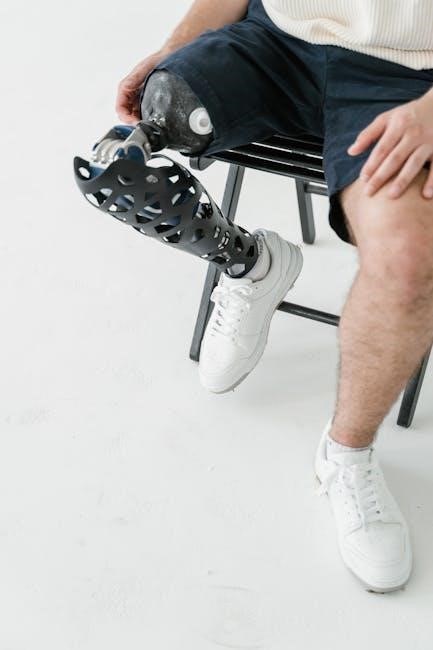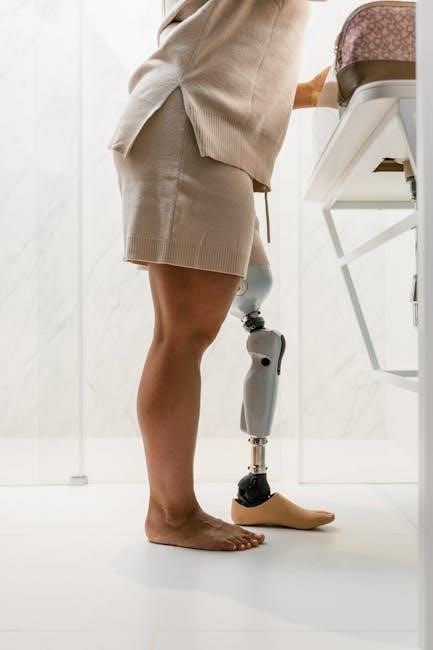Total hip replacement rehabilitation is a structured program aimed at restoring function, mobility, and strength after surgery. A multidisciplinary approach ensures optimal recovery and lasting outcomes.
1.1. Overview of Total Hip Replacement
Total hip replacement is a surgical procedure where the damaged femoral head and acetabulum are replaced with artificial components. The femur’s head is removed and replaced with a metal or ceramic ball, while the acetabulum is fitted with a metal socket. This restores joint function, alleviating pain and improving mobility. The artificial components mimic natural hip movement, allowing patients to perform daily activities with ease. Recovery involves a structured rehabilitation program to ensure proper healing and optimal outcomes. Following the surgery, patients are guided through exercises and precautions to avoid complications and achieve full mobility. The goal is to enhance quality of life by restoring strength, flexibility, and range of motion. Adherence to the rehabilitation protocol is crucial for long-term success.
1.2. Importance of Rehabilitation in Recovery
Rehabilitation is a cornerstone of recovery after total hip replacement, essential for restoring strength, mobility, and function. It minimizes complications, reduces pain, and promotes independence. A structured program addresses muscle weakness, improves balance, and prevents dislocation. Early mobilization enhances blood circulation, reducing swelling and risk of blood clots. Tailored exercises, such as hip abduction and ankle pumps, strengthen muscles around the hip joint. Therapy also improves range of motion, enabling patients to perform daily activities. Without proper rehabilitation, patients may face prolonged recovery, limited mobility, and increased risk of falls or joint instability. Adherence to the rehabilitation protocol ensures faster return to normal activities and improves overall quality of life. Thus, it is vital for achieving long-term success and maximizing surgical outcomes. Consistency and patience are key to successful rehabilitation.

Immediate Post-Surgical Phase (0-2 Weeks)
This phase focuses on pain management, wound healing, and early mobilization. Patients begin with non-weight-bearing activities and gentle exercises like ankle pumps and quad sets to maintain circulation and strength.
2.1. Initial Recovery and Pain Management Strategies
The immediate post-surgical phase focuses on managing pain and promoting wound healing. Patients are typically prescribed analgesics to alleviate discomfort and inflammation. Ice therapy and elevation of the affected leg are commonly recommended to reduce swelling. Gentle exercises, such as ankle pumps and quad sets, are initiated to maintain circulation and prevent muscle atrophy. Pain management strategies are tailored to individual tolerance, ensuring the patient remains comfortable while progressing through early mobilization. Proper rest and adherence to medication schedules are emphasized to support the healing process. These initial steps lay the foundation for a successful rehabilitation journey, enabling patients to gradually increase activity levels without compromising recovery.
2.2. Early Mobilization Techniques
Early mobilization is critical to prevent complications and promote healing. Patients are encouraged to begin gentle movements within the first few days post-surgery. Techniques include ankle pumps to improve circulation, quad sets to strengthen thigh muscles, and controlled hip abduction exercises to maintain joint stability. Assisted devices like crutches or walkers are often used to facilitate safe ambulation. Patients are guided through seated or standing exercises, focusing on proper posture and movement mechanics. These activities are typically performed in a supervised setting, such as a hospital or home environment, to ensure adherence to rehabilitation protocols. Early mobilization helps restore mobility, reduces stiffness, and prepares the patient for more advanced exercises in subsequent phases of recovery. Consistency and adherence to these techniques are vital for optimal outcomes.

Early Rehabilitation Phase (2-6 Weeks)
This phase focuses on gentle exercises to enhance mobility and strength, with precautions to avoid complications. Supervised activities aim to restore function and promote gradual recovery.
3.1. Gentle Exercises for Mobility
Gentle exercises during the early rehabilitation phase focus on improving mobility and strength without overexertion. These exercises are designed to promote healing and restore function gradually. Common exercises include ankle pumps, straight leg raises, and seated marching. Patients are encouraged to perform these exercises several times daily as directed by their physical therapist. These activities help restore range of motion, reduce stiffness, and strengthen the muscles around the hip joint. Consistency is key to achieving optimal results and preventing complications. Patients should avoid movements that could dislocate the hip, such as crossing the legs or bending past 90 degrees. Regular practice under guidance ensures a safe and effective recovery process.
3.2. Precautions to Avoid Complications
Avoiding certain movements is crucial to prevent complications after total hip replacement. Patients must avoid hip flexion beyond 90 degrees, crossing legs, and excessive internal or external rotation. Weight-bearing status should be followed as advised, often requiring crutches or a walker initially. Proper bending and lifting techniques, such as keeping the back straight and bending at the knees, are essential to avoid strain. Avoiding prolonged sitting and ensuring proper posture can reduce discomfort and risk of dislocation. Adherence to these precautions ensures proper healing and minimizes the risk of complications, allowing for a smoother and more effective recovery process. Consistency in following these guidelines is vital for achieving long-term success and avoiding setbacks.

Intermediate Rehabilitation Phase (6-12 Weeks)
This phase focuses on strengthening muscles, improving balance, and enhancing functional mobility. Exercises include resistance bands, light weights, and proprioception drills to prepare for daily activities.
4.1. Strengthening Exercises
During the intermediate phase, strengthening exercises focus on building hip and surrounding muscle strength to enhance stability and functional ability. Common exercises include straight leg raises, clamshell exercises, and resistance band work. These exercises target the glutes, quads, and core muscles, which are crucial for hip stability. Patients are encouraged to use light weights or resistance bands to gradually increase intensity. Progression is tailored to individual recovery, ensuring muscles are challenged without overexertion. Consistency is key to rebuilding strength and preparing for more advanced activities. Supervised physical therapy sessions often include dynamic exercises to improve joint mechanics and reduce the risk of future complications. Strengthening at this stage lays the foundation for returning to daily activities and hobbies safely and effectively.
4.2. Improving Balance and Proprioception
Improving balance and proprioception is crucial during the intermediate phase of rehabilitation to restore stability and coordination. Exercises such as single-leg stands, heel-to-toe walking, and wobble board training are commonly used. These activities enhance the body’s ability to sense its position and movement, reducing the risk of falls. Patients often perform these exercises with support initially and gradually progress to unsupported tasks as confidence and ability improve. Balance drills, such as standing on soft surfaces or eyes-closed exercises, further challenge proprioception. Supervised physical therapy sessions ensure proper technique and progression. Strengthening muscles around the hip joint also supports better balance. Consistent practice helps patients regain their equilibrium and coordination, which are essential for returning to daily activities and maintaining independence. Regular assessment by therapists tailors exercises to individual needs and progress.
Advanced Rehabilitation Phase (3-6 Months)
This phase focuses on restoring full mobility and strength through advanced exercises and progressive resistance training, enabling patients to return to normal activities and sports safely.
5.1. Advanced Exercises for Full Mobility
Advanced exercises focus on achieving full hip mobility and functional strength. Activities include dynamic balancing, single-leg squats, and resistance band workouts. These exercises enhance flexibility and muscle control, preparing patients for daily activities and sports. Proper form and progression are emphasized to avoid complications. Patients are encouraged to gradually increase intensity under professional guidance to ensure a safe and effective recovery process.
5.2. Progressive Resistance Training
Progressive resistance training is essential for rebuilding hip strength and endurance post-surgery. Using resistance bands or light weights, patients perform exercises like leg presses and step-ups. This method gradually increases muscle load, promoting functional recovery. Supervised by therapists, patients focus on proper form to prevent injury. Over time, resistance levels are adjusted to match strength gains, ensuring continuous improvement. This training also addresses muscle imbalances, enhancing overall stability and mobility. The goal is to restore the hip’s functional capacity, enabling patients to return to daily activities and more strenuous tasks confidently and safely.

Precautions and Activity Modifications
Patients must avoid excessive hip flexion, adduction, and internal rotation. Using assistive devices and proper bending techniques is crucial to prevent dislocation and ensure safe recovery.
6.1. General Precautions Post-Surgery
After total hip replacement, patients must adhere to specific precautions to minimize complications. Avoiding hip flexion beyond 90 degrees, excessive internal or external rotation, and adduction past the midline is critical. Using assistive devices like crutches or walkers is recommended to reduce stress on the hip joint. Proper bending and lifting techniques, such as keeping the back straight and bending at the knees, are essential. Patients should avoid crossing their legs or ankles and refrain from sitting in low chairs or bending forward excessively. These precautions help prevent dislocation and ensure proper healing. Compliance with these guidelines is vital during the early recovery phase to promote optimal outcomes and long-term success of the surgery.
6.2. Activity-Specific Modifications
Activity-specific modifications are essential to ensure safe participation in daily tasks post-surgery. Patients should avoid high-impact activities like running or jumping, opting instead for low-impact exercises such as swimming or cycling. When sitting, using a raised toilet seat and chairs with good lumbar support is recommended to reduce strain on the hip. Sleep position modifications, such as using a pillow between the knees, can help maintain proper alignment. Driving should be avoided initially until cleared by a healthcare provider. Additionally, activities requiring heavy lifting or repetitive bending should be modified or delegated. These adjustments help protect the hip joint during the healing process, reducing the risk of complications and promoting a successful recovery.

Role of Physical Therapy
Physical therapy is crucial for recovery after total hip replacement, offering structured exercises to reduce pain, enhance mobility, and strengthen muscles, ensuring a safe return to daily activities.
7.1. Inpatient and Outpatient Therapy Programs
Inpatient therapy begins immediately after surgery, focusing on basic mobility, pain management, and safety training. Patients learn to walk with assistive devices and perform daily tasks safely. Outpatient programs continue this progress, offering structured sessions to improve strength, balance, and range of motion. Both settings ensure a tailored approach, addressing individual needs and promoting a smooth transition to independent living. Therapy programs are designed to maximize recovery efficiency, reducing complications and enhancing overall function. Regular attendance and adherence to the prescribed exercises are essential for achieving optimal outcomes and returning to normal activities as quickly as possible.
7.2. Tailoring Therapy to Individual Needs
Therapy programs are personalized to address each patient’s unique needs, ensuring optimal recovery. Assessments of strength, mobility, and overall health guide the creation of customized plans. Patients with specific limitations or goals receive targeted interventions, such as modified exercises or additional support. Progress is continuously monitored, and programs are adjusted to reflect improvements or challenges. This tailored approach ensures that rehabilitation is both effective and sustainable, promoting faster return to daily activities. By focusing on individualized care, therapy maximizes outcomes and helps patients achieve their personal recovery goals, whether it’s regaining mobility for work or improving strength for leisure activities.

Patient Education and Empowerment
Patient education empowers individuals to understand their rehabilitation protocol, recognize progress, and adhere to guidelines. Clear communication fosters confidence, enabling active participation in recovery and reducing complications.
8.1. Understanding the Rehabilitation Protocol
Understanding the rehabilitation protocol is crucial for a successful recovery after total hip replacement. The protocol outlines a structured program to restore mobility, strength, and function. It includes phases like immediate post-surgical care, early mobilization, and advanced exercises, each tailored to promote healing and prevent complications. Patients learn about activity modifications, such as avoiding certain movements, and the importance of adherence to these guidelines. The protocol also emphasizes monitoring progress and adjusting therapies based on individual needs. Clear communication with healthcare providers ensures patients grasp their roles in recovery. Educational resources, like manuals or guidelines, provide detailed instructions, helping patients stay informed and engaged in their rehabilitation journey.
8.2. Patient’s Active Role in Recovery
The patient plays a vital role in their recovery, as adherence to the rehabilitation protocol directly impacts outcomes. Active participation in exercises, therapy sessions, and lifestyle modifications is essential. Patients must commit to following prescribed routines, including daily exercises and activity precautions, to ensure proper healing and prevent complications. Staying motivated and informed about their progress fosters a sense of control and responsibility. Open communication with healthcare providers allows patients to address concerns and adjust their recovery plan as needed. By taking an active role, patients empower themselves to achieve a faster and more successful rehabilitation, promoting independence and improving overall quality of life post-surgery.
Psychological Aspects of Recovery
Patient engagement is crucial for successful rehabilitation post-total hip replacement, as active participation in prescribed exercises and therapies ensures proper healing and minimizes complications, fostering independence and improved quality of life.
9.1. Emotional Recovery and Mental Health
Emotional recovery is a vital component of total hip replacement rehabilitation, as surgery and recovery can significantly impact mental health. Patients may experience anxiety, depression, or frustration due to pain, limited mobility, and lifestyle adjustments. Addressing these emotional challenges is essential to ensure a smooth recovery. Support systems, such as counseling or support groups, can help patients cope with emotional setbacks. Additionally, setting realistic expectations and celebrating small milestones can enhance mental well-being. A positive mindset and adherence to the rehabilitation protocol contribute to a successful and fulfilling recovery journey. Prioritizing mental health ensures patients not only regain physical strength but also achieve emotional resilience and overall quality of life.
9.2. Coping with Setbacks and Challenges
Coping with setbacks during total hip replacement rehabilitation requires resilience and effective strategies. Patients may face challenges like pain, limited mobility, or emotional frustration. Maintaining a positive mindset and setting realistic expectations can help navigate these difficulties. Seeking support from family, friends, or support groups can alleviate emotional strain. Professional counseling may also be beneficial for addressing mental health concerns. Adjusting to lifestyle changes and celebrating small achievements can boost morale. Proper pain management and adherence to the rehabilitation protocol are crucial for overcoming obstacles. Open communication with healthcare providers ensures tailored solutions to challenges; By addressing setbacks proactively, patients can stay motivated and achieve a successful recovery. Overcoming challenges fosters confidence and accelerates the journey toward full mobility and independence.

Returning to Normal Activities
Returning to normal activities after total hip replacement requires gradual resumption of daily tasks, work, and leisure. Patients should follow guidelines to ensure safe and effective reintegration into routine life.
10.1. Guidelines for Daily Activities
Following a total hip replacement, patients should adhere to specific guidelines to safely resume daily activities. Initially, light tasks such as cooking or light cleaning are recommended, while avoiding heavy lifting or bending. Proper bending techniques, like using assistive devices or keeping the back straight, are essential to prevent dislocation. Activities requiring excessive hip flexion, such as crossing legs or sitting in low chairs, should be avoided. Patients are encouraged to use adaptive equipment, such as grabbers or elevated toilet seats, to reduce strain on the hip joint. Gradual progression to more strenuous activities is advised, with a focus on maintaining proper posture and avoiding high-impact movements. These guidelines help ensure a smooth transition back to daily routines while protecting the hip replacement.
10.2. Returning to Work and Leisure
Returning to work and leisure activities after total hip replacement requires careful planning and adherence to rehabilitation guidelines. Patients should gradually resume work, considering the physical demands of their job, with modifications to avoid heavy lifting, prolonged standing, or repetitive bending. Leisure activities should focus on low-impact exercises, such as swimming or cycling, to promote mobility without risking hip dislocation. High-impact sports, like running or jumping, are generally discouraged until cleared by a healthcare provider. Timing for return varies, but most patients can resume desk work within 4-6 weeks and manual labor within 3-4 months. Consistency with therapy protocols and proper precautions ensures a safe transition back to daily and recreational activities, promoting long-term hip health and functionality.
Long-Term Outcomes and Expectations
Total hip replacement typically offers improved function, reduced pain, and enhanced quality of life. With proper care, prosthetics can last decades, ensuring long-term mobility and independence.
11.1. Expected Outcomes of Rehabilitation
Following a total hip replacement, patients can expect significant improvements in mobility, strength, and overall hip function. Rehabilitation aims to restore range of motion, reduce pain, and enhance quality of life. Most patients achieve independence in daily activities, with many returning to leisure activities and work. The artificial joint provides durability, allowing for long-term stability and function. Psychological well-being also improves as patients regain confidence in their mobility. Proper adherence to rehabilitation protocols ensures optimal outcomes, minimizing the risk of complications. Over time, patients often experience near-normal hip function, enabling them to maintain an active lifestyle for years post-surgery.
11.2. Long-Term Care and Maintenance
Long-term care and maintenance after total hip replacement are crucial for ensuring the durability and functionality of the artificial joint. Patients should avoid high-impact activities that may stress the hip, such as excessive running or repetitive heavy lifting. Regular follow-ups with healthcare providers are essential to monitor the hip’s condition and address any potential issues early. Proper wound care and infection prevention measures should continue to be practiced. Additionally, patients are encouraged to maintain a healthy weight to reduce stress on the joint. Adhering to activity modifications and avoiding unsafe movements, such as crossing legs or excessive internal rotation, helps prevent dislocation. Over time, patients play a key role in maintaining their hip health through adherence to these guidelines.